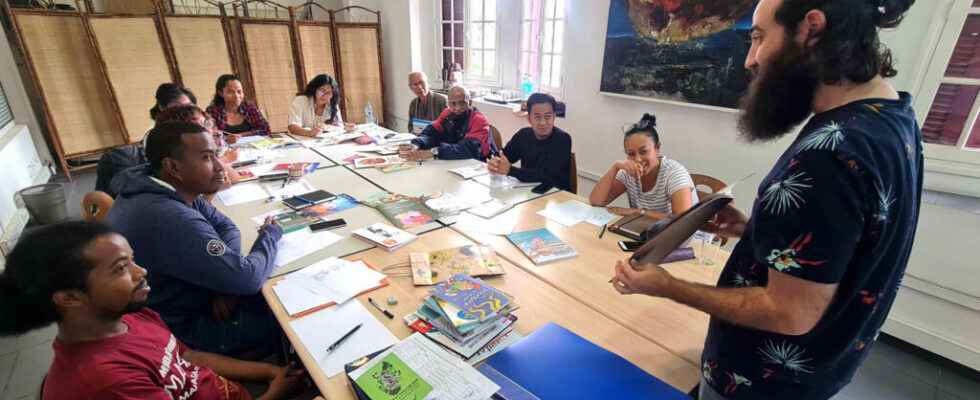Since Monday, December 12, the French Institute of Madagascar offers ten illustrators of children’s literature a professionalization residence, led by Sess, author-illustrator of children’s books. The goal: to gain skills and know the workings of publishing to one day access the publication.
With our correspondent in Antananarivo, Sarah Tetaud
They are gifted, their drawings could amaze thousands of children, but they have trouble finding a publisher. The ten youth illustrators in residence for a week at the Institut français de Madagascar listen to the advice of designer Sess: “ There, you have the text of Red Riding Hood, you choose a passage for me, and you try to find a somewhat original way of representing it to me. Not what is written verbatim in the text, okay ? Abandon your habits, get out of clichés. Sess confuses his audience.
” Me, I would find it cool, since we’re in Madagascar, for Red Riding Hood to be assimilated to here, it can be nice, rather than drawing something traditional. Get inspired by your decor, your traditions, it’s a strength to use them. “, insists the author-illustrator.
Print his paw
” It’s part of the creative process. Sess details. This is where you take a bit of your wings, your independence as an illustrator, where you find your signature. Because anyone can portray a typical scene of a child walking if it’s written in the text. What will make the difference, and the more professional side, is how we will represent it? Are we going to make the choice to put ourselves in the sight of the little boy, are we going to move away? Are we going to do a close-up of his hand, his mouth, his walking feet? The illustration is supposed to accompany a text and take it a little further. »
” Well, I learned that today! Me, when I am given a scenario, I just redraw what is on the text! The illustrator Sese Dille, 26, confides – amused – to being shaken up in her way of working: “ The advice he gave us earlier was very interesting, which we had to interpret in our own way rather than just copying the text into a drawing… »
The importance of showing your work
Passionate about stories that sparkle, Sese Dille begins to live from her work. The reflections initiated by the French designer allow him to broaden his horizons. ” During the workshop, Sess told us that we can draw inspiration from everyday life, from the little worries of our life, on the grounds that there will always be people who can identify with what we write. , she says. I had never thought of it… So, yes, I’m going to get out of my comfort zone which is storytelling, to talk and draw other things. »
► To read also: Once upon a time… diversity in children’s literature
Another challenge is to gain notoriety. To then go and knock on the door of the editors by showing them a work. For Sess, internet and social networks abolished borders and financial barriers. ” It doesn’t take much. Already, even an Instagram page, it’s stupid, but it’s the basis. Me, that’s what allowed me to make my little hole, says the designer. And also, choose carefully what you decide to show. » For those who want to go further, there is ” full of free online portfolios, Ultra-book type, which is a gallery platform. The free version allows you to put 25 images. This is quite enough to show his work. »
A branch of literature that is too underdeveloped
This professionalization residence started from an observation: the offer of children’s literature in Madagascar is ” relatively poor “, according to Florence Dimani, head of the media library of the French Institute of Madagascar. ” There have been great developments in recent years, but to date, we see that there are few books in the Malagasy language available to the public, and very few in terms of diversity and style, does she regret. We have a lot of tales, but few albums, few comic strips… For example, we have identified less than 200 books in the Malagasy language, available to young people, that is to say an audience from 0 to 15 years old. »
The offer of children’s literature in Madagascar, we can say that it is relatively poor
Florence Dimani, head of the media library of the French Institute of Madagascar
The residency ends on Saturday at the French Institute with a morning during which the artists will be able to show the work they have produced. A kind of “speed-dating” with local publishers is also planned, specifies Florence Dimani, so that the illustrators can “ expand their address book and possibly make contracts, to enlarge the titles of Malagasy children’s literature. »
Attracting the attention of publishers thanks to digital, taking illustration off the beaten track, enough to breathe new life into Malagasy children’s literature and allow its authors to offer themselves a multitude of horizons.
